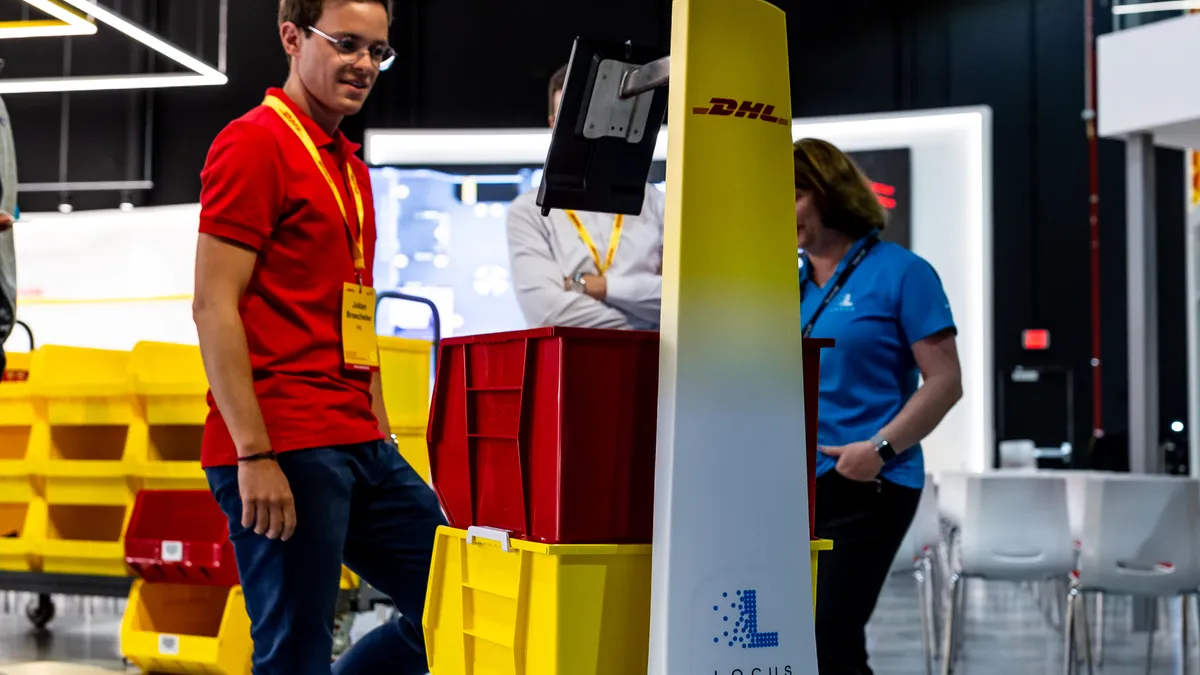Dive Brief:
- DHL Supply Chain is partnering with Blue Yonder, a fulfillment solutions provider specializing in artificial intelligence technology, to build an integrated warehouse robotics management system that will run on Microsoft Azure IoT's cloud service, according to a press release Wednesday.
- The platform will allow customers to standardize onboarding and operations data for various types of warehouse robotics across multiple vendors, allowing companies to customize their fleet of robots to their needs. In a DHL pilot in one of its warehouses in Madrid with 6 River Systems, the platform cut integration and programming time to get new robots up and running by 60%, according to the release.
- As the product rolls out, integration time could be reduced by as much as 90%, Markus Voss, global CIO and COO at DHL Supply Chain, said in a statement. Once a customer uses the platform to select the vendor and type of robots to deploy, and completes the onboarding process, the platform uses machine learning to manage warehouse tasks.
Dive Insight:
DHL has been exploring the use of warehouse technologies from wearables to cobots and robots across its global sites. Its Vision Picking program gave workers Google smart glasses which allowed them to locate and scan barcodes without the need for paper forms or a handheld scanner, which DHL said increased efficiency and reduced mistakes.
DHL has also partnered with Locus Robotics to integrate robots that can pick inventory for workers to sort, cutting down on the amount of time employees spend walking in the warehouse.
"By replacing monotonous, repetitive and particularly strenuous activities," Voss said, "the aim is not to replace employees over time, but to assign the more attractive and interesting tasks to our human workforce."
As warehouses integrate autonomous solutions, a robotics as a service (RaaS) model has taken off. Instead of a company having to make a large investment up front to buy and install robots, it can contract with a vendor and pay incrementally, giving the company greater flexibility to swap devices and providers in and out to suit its needs.
"These robots don't need their own infrastructure," Adrian Kumar, global head of operations science and analytics at DHL Supply Chain, told Supply Chain Dive in an interview, referring to the fixed mounts, conveyor belts or tracks industrial robots require. "We can lease them as we go and we can inject them into our existing infrastructure ... and they work collaboratively with people."
One of the challenges that comes with this approach is integrating different types of robots, or robots from different vendors, into a single system that allows warehouse managers to ensure everything is running efficiently.
"We have more than 2,000 operational sites across DHL Supply Chain," Voss said, "so we know how complex, time-consuming and costly it can be to integrate new robots into existing platforms and connect to our clients' various warehouse management systems."
By creating a way for these separate technologies to connect to each other and manage tasks within the warehouse, customers can take advantage of the flexibility RaaS offers without significant downtime between vendor changes or hardware upgrades.
This could be particularly useful during peak season, Girish Rishi, CEO of Blue Yonder, said in a statement, allowing a company to "bring on a robotics vendor quickly to augment its resource capacity and support its workforce."













